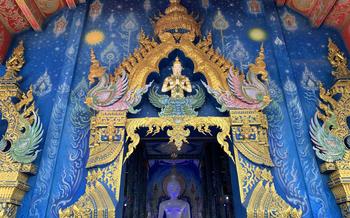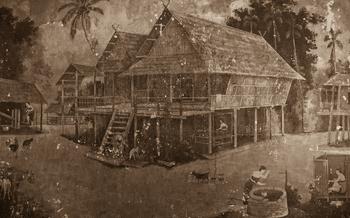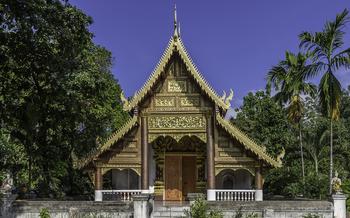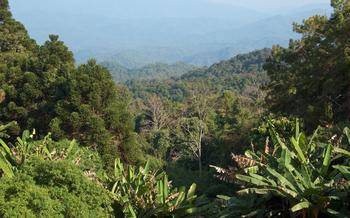
Wat Pa Daet
- Significance of Wat Pa Daet: A Haven of Spirituality and Cultural Heritage
- Exploring the Temple Grounds
- The Revered Buddha Image
- Meditation and Spiritual Retreats
- Stunning Natural Surroundings
- Local Markets and Handicrafts
- Local Cuisine and Delicacies: A Culinary Journey in Phayao
- Accommodation Options Nearby:
- Transportation and Getting There
- Visiting Etiquette and Dress Code: A Guide to Respectful Conduct
- Photography and Videography
- Insider Tip: A Hidden Gem Unveiled
Significance of Wat Pa Daet: A Haven of Spirituality and Cultural Heritage
, holds a profound significance in the realm of Buddhism and cultural heritage. This revered temple, dating back to the 15th century, is renowned for its sacred Buddha image, exquisite architecture, and spiritual aura that attracts pilgrims and travelers from around the world.
Located in the heart of Phayao, Wat Pa Daet is easily accessible, offering visitors a convenient pilgrimage or exploration opportunity. Its serene setting invites devotees and travelers to immerse themselves in the tranquility of the temple grounds and experience the rich spiritual heritage that permeates the atmosphere.
The architectural features of Wat Pa Daet are a testament to the craftsmanship and artistic prowess of its builders. The temple complex boasts intricate carvings, delicate murals, and stunning stupas that reflect the Lanna architectural style. Unique elements, such as the towering chedi adorned with intricate mosaic patterns, set this temple apart from others in the region.
Beyond its architectural splendor, Wat Pa Daet holds deep spiritual significance. The temple is home to a revered Buddha image known as Phra Chao Tan Jai, which is believed to possess miraculous powers and is the focal point of religious ceremonies and rituals. Devotees flock to the temple to pay homage to the sacred image, seeking blessings, guidance, and spiritual fulfillment.
The temple's spiritual significance extends beyond its religious ceremonies. Wat Pa Daet is also a renowned center for meditation and spiritual retreats, offering visitors the opportunity to deepen their spiritual practice and find inner peace amidst the tranquil surroundings.
Exploring the Temple Grounds
Wat Pa Daet's temple complex showcases a captivating layout, with serene pathways leading visitors through its sacred grounds. The main ordination hall, known as the Ubosot, stands as the heart of the temple, a stunning example of Lanna-style architecture. Its intricate wooden carvings and ornate decorations are a testament to the skill and artistry of local craftsmen. Within the Ubosot, visitors can marvel at the magnificent Buddha image enshrined in the main altar, radiating an aura of peace and tranquility.
Beyond the Ubosot, visitors can explore the temple's other notable buildings, each serving a unique purpose. The Sala Kan Parian, or Assembly Hall, is where monks gather for religious ceremonies and teachings. The Sala Lai Nam, or Water Pavilion, is a tranquil spot where visitors can relax and reflect by the serene pond. The Chedi, or stupa, represents the Buddha's teachings and is an iconic symbol of the temple.
The temple grounds are adorned with intricate murals and sculptures, depicting scenes from the life of Buddha and other religious stories. These artworks serve as a visual narrative, inviting visitors to delve deeper into the temple's spiritual significance. Among the many treasures of Wat Pa Daet are sacred objects and relics, such as ancient manuscripts, Buddha statues, and amulets, which are carefully preserved and revered by the monks and devotees.
The Revered Buddha Image
At the heart of Wat Pa Daet's spiritual significance lies the revered Buddha image enshrined within the main ordination hall. This majestic statue, known as Phra Chao Thong Thip, exudes an aura of tranquility and serenity that captivates visitors. Crafted from pure gold, the Buddha image stands tall, commanding respect and devotion.
The history of Phra Chao Thong Thip is shrouded in mystery and legend. It is believed to have been created in the 15th century by a renowned artisan named Phraya Wisut Krasat, who was commissioned by King Tilokarat of the Lanna Kingdom. According to local folklore, the king had a vision in which he saw a golden Buddha statue floating down the Ping River. He subsequently ordered the construction of Wat Pa Daet to house the sacred image.
Phra Chao Thong Thip is unique in its design and features. The statue depicts the Buddha in a seated meditation posture, with his right hand raised in the gesture of dispelling fear and his left hand resting gently on his lap. The Buddha's serene expression and intricate detailing reflect the exceptional craftsmanship of its creator.
Devotees from far and wide flock to Wat Pa Daet to pay homage to Phra Chao Thong Thip. They believe that the image possesses miraculous powers and can grant wishes and blessings to those who pray with sincerity. Numerous stories and legends have been passed down through generations, recounting the miraculous interventions of the Buddha image in people's lives.
Visitors to Wat Pa Daet are invariably drawn to the captivating presence of Phra Chao Thong Thip. Whether they are devout Buddhists or simply seekers of spiritual fulfillment, the image's serene beauty and powerful aura leave a lasting impression that resonates long after their visit.
Meditation and Spiritual Retreats
Wat Pa Daet offers visitors the opportunity to delve deeper into meditation practices and spiritual growth through organized meditation sessions and spiritual retreats. These programs are designed to provide a serene and conducive environment for individuals seeking inner peace and a closer connection to their spiritual selves.
Meditation sessions are conducted regularly by experienced monks who guide participants through various techniques, including mindfulness meditation, loving-kindness meditation, and breath meditation. These sessions are open to people of all levels of experience, from beginners to seasoned practitioners.
For those seeking a more immersive experience, Wat Pa Daet also offers spiritual retreats that range from a few days to several weeks in duration. These retreats provide a structured program of meditation, teachings, and spiritual practices that allow participants to fully immerse themselves in the Buddhist way of life.
During these retreats, participants learn about Buddhist philosophy, practice meditation under the guidance of experienced teachers, and engage in discussions and teachings that deepen their understanding of the Buddha's teachings. The retreats provide a unique opportunity for individuals to step away from their daily lives and focus on their spiritual development in a peaceful and supportive environment.
Stunning Natural Surroundings
Wat Pa Daet is not just a spiritual sanctuary but also a haven of natural beauty. The temple grounds are adorned with meticulously landscaped gardens, serene ponds, and lush forests, creating a tranquil and picturesque environment. Visitors can stroll through the gardens, admiring the vibrant flowers and exotic plants, or relax by the tranquil ponds, listening to the gentle sounds of water. The forests surrounding the temple are home to a variety of wildlife, including birds, squirrels, and monkeys, providing ample opportunities for birdwatching and wildlife enthusiasts. The natural surroundings of Wat Pa Daet offer a serene escape from the hustle and bustle of city life, allowing visitors to reconnect with nature and find inner peace.
Local Markets and Handicrafts
In the vicinity of Wat Pa Daet, visitors can immerse themselves in the vibrant local markets and discover a treasure trove of handicrafts and souvenirs. These bustling marketplaces offer a glimpse into the region's rich cultural heritage and provide opportunities to support local artisans.
Stalls adorned with colorful textiles, intricate wood carvings, and shimmering silverware line the market streets. Visitors can browse an array of unique items, including handmade jewelry, ceramic pottery, and traditional Thai clothing. Bargaining is a common practice, and visitors can engage with friendly vendors to negotiate prices while supporting local businesses.
Among the must-have souvenirs from Phayao are the exquisite silk and cotton fabrics, renowned for their vibrant colors and intricate patterns. Visitors can also find a variety of bamboo and rattan handicrafts, such as baskets, mats, and decorative pieces, which showcase the region's skilled craftsmanship.
For those seeking spiritual mementos, the markets offer a selection of religious artifacts, including Buddha statues, amulets, and prayer beads. These items are not only beautiful but also hold deep cultural and religious significance.
Whether searching for unique souvenirs or simply experiencing the vibrant local atmosphere, the markets near Wat Pa Daet are a must-visit for travelers seeking an authentic glimpse into Thai culture and craftsmanship.
Local Cuisine and Delicacies: A Culinary Journey in Phayao
Phayao's culinary scene offers a symphony of flavors that tantalize the taste buds. Embark on a gastronomic adventure and savor the region's delectable dishes. Khao Soi, a hearty noodle soup with coconut milk and curry paste, is a must-try. Savor the rich broth and tender noodles, topped with crispy wontons and pickled mustard greens.
Indulge in Sai Ua, a grilled pork sausage infused with aromatic herbs and spices. Its smoky flavor and juicy texture will leave you craving for more. For a refreshing treat, relish Khanom Jeen, rice noodles served with various curries and toppings. The interplay of flavors and textures in this dish is simply irresistible.
Vegetarians and vegans will find plenty of options to satisfy their cravings. Gaeng Hang Lay, a vegetable curry with jackfruit and bamboo shoots, offers a burst of flavors and nutrients. Sai Krok Isan, a fermented sausage made from soy and rice, is a unique and savory snack.
Don't miss the opportunity to explore the local markets, where you can find an array of fresh produce, spices, and homemade delicacies. Engage with friendly vendors and learn about the culinary traditions of the region.
Insider Tip:
For an authentic culinary experience, venture off the beaten path and visit local street food stalls. These humble eateries often serve the most delicious and affordable dishes, giving you a true taste of Phayao's culinary delights.
Accommodation Options Nearby:
When planning your visit to Wat Pa Daet, consider staying in the vicinity to fully immerse yourself in the local culture and enjoy the tranquil atmosphere. A range of accommodation options is available near the temple, catering to different budgets and preferences.
For a truly authentic experience, opt for a homestay with a local family. Homestays offer a glimpse into the daily lives of the Phayao people and provide an opportunity to learn about their customs and traditions firsthand. Several homestays are located within walking distance of the temple, allowing for easy access and exploration.
Budget-conscious travelers can find affordable guesthouses and hostels in the vicinity. These accommodations typically offer basic amenities such as comfortable beds, clean bathrooms, and shared common areas. Some guesthouses also provide bicycle rentals, allowing visitors to explore the surrounding countryside at their own pace.
For those seeking a more luxurious stay, several hotels are located within a short drive of Wat Pa Daet. These hotels offer modern amenities, spacious rooms, and often have swimming pools and fitness centers. Some high-end hotels also offer spa treatments and other wellness facilities, providing a relaxing retreat after a day of temple exploration.
When choosing your accommodation, consider factors such as your budget, desired level of comfort, and proximity to the temple. Booking your stay in advance, especially during peak tourist season, is recommended to secure your preferred accommodation and avoid disappointment.
Transportation and Getting There
Reaching Wat Pa Daet is a breeze with various transportation options available. From major cities like Bangkok or Chiang Mai, you can hop on a comfortable bus or train that will take you directly to Phayao. The journey by bus typically ranges from 8 to 10 hours, while the train ride offers a more scenic experience and takes around 12 to 14 hours. Once in Phayao, local transportation, such as tuk-tuks or songthaews, can be easily arranged to take you to the temple, which is situated approximately 15 kilometers from the city center. The ride from Phayao to the temple takes about 30 minutes, and the cost varies depending on the mode of transport chosen. If you prefer a more independent mode of travel, renting a car or hiring a taxi is also an option, providing you the freedom to explore the surrounding areas at your own pace.
Visiting Etiquette and Dress Code: A Guide to Respectful Conduct
When visiting Wat Pa Daet, it is essential to observe appropriate etiquette and dress code out of respect for the sacred nature of the temple. Here are some guidelines to follow:
-
Dress Modestly: Before entering the temple grounds, ensure you are dressed modestly. Shoulders and knees should be covered, and revealing clothing is not appropriate. Avoid wearing shorts, tank tops, or anything that might be considered disrespectful.
-
Remove Shoes: Upon entering the temple, remove your shoes and place them neatly in the designated shoe rack. This is a common practice in Buddhist temples to maintain cleanliness and show respect.
-
Be Mindful of Your Behavior:
Photography and Videography
When visiting Wat Pa Daet, it is essential to be mindful of the temple's sacred nature and respect the privacy of the monks and other visitors. Photography and videography are generally permitted within the temple grounds, but it is crucial to adhere to certain guidelines.
Before taking any photos or videos, seek permission from the temple authorities or monks. This shows respect for their customs and ensures that you do not disrupt any religious ceremonies or activities.
Avoid using flash photography, as it can be disruptive and disrespectful. Instead, opt for natural lighting or use a low-light setting on your camera.
When photographing monks, always ask for their permission and be respectful of their time and space. Do not take photos of them during meditation or other religious practices without their consent.
Refrain from taking photos or videos of sensitive areas within the temple, such as the monks' living quarters or private altars. Respect the privacy of the monks and other visitors, and avoid capturing images that may be considered intrusive or disrespectful.
When capturing the beauty of the temple's architecture, murals, and sculptures, ensure you do so in a way that preserves the sacredness of the space. Avoid using angles or compositions that may detract from the temple's spiritual significance.
Remember, the primary purpose of visiting Wat Pa Daet is to experience its spiritual atmosphere and connect with its history and traditions. While photography and videography can be a way to document your visit, it is essential to prioritize respect and mindful behavior above capturing the perfect shot.
Insider Tip: A Hidden Gem Unveiled
Beyond the main temple complex, nestled amidst lush greenery, lies a hidden gem waiting to be discovered. Follow a secluded path to uncover a serene pond adorned with vibrant lotus flowers. As you approach, the gentle sound of trickling water from a nearby fountain fills the air, creating a tranquil ambiance. Take a moment to sit by the pond, immerse yourself in the peaceful atmosphere, and let the beauty of nature soothe your soul. This hidden oasis offers a unique perspective of the temple, allowing you to appreciate its tranquility away from the hustle and bustle of the main grounds.





